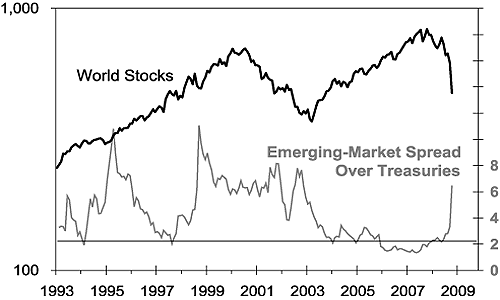| Home | About Us | Resources | Archive | Free Reports | Market Window |
This Is One of the Great Buying Opportunities of the Last 30 YearsBy
Thursday, November 13, 2008
As longtime readers of my advisory can tell you, I haven't been bullish on the stock market in years. It turns out that was very close to a huge top in asset prices. Stocks, bonds, commodities, foreign currencies all peaked over the next several months.
It was easy to see this peak coming with three key points: the number of stocks trading at reasonable prices (a lack of value), the amount of insider buying in the stock market (a lack of knowledgeable buyers), and the spread between emerging-market bonds and U.S. Treasury bonds (a lack of fear). Reviewing these key data points today shows we're building an important bottom instock prices. And it's why I'm telling everyone I know that this is one of the great buying opportunities of the last 30 years.
What about that lack of fear?
In about a year, we've moved from a period of complete complacency to absolute terror. Paradoxically – and this is hard for most people to understand – you want to be a buyer of equities when everyone else is panicking. Yes, our economy is struggling right now with huge problems. Enormous risks threaten America's leadership in the world, the dollar's status as the world's reserve currency, our energy supplies, the rule of law in this country, etc. But all of these risks – all of them – existed a year ago, when stocks were almost 100% higher, on average. And all of these risks will exist 10 years from now, when stocks have gone up three or four times from their averages now.
Further Reading:
The Risk in Stocks Hasn't Been This Low in 34 Years Market NotesIF IT'S THIS ROUGH ON GOOGLE, IT'S KILLING RADIO
The "world's best brand" is becoming worth a little bit less each day.
As we covered a few months ago, most folks consider Google the world's best brand. It's revolutionized access to information and consumers. Heck... the company is so good, it became its own verb. Good as it is, Google is an advertising business. And when companies conserve cash in an economic crisis, ad budgets are the first thing to get slashed. Google is also hugely popular with mutual-fund managers. When investors get disgusted with these managers, they ask for their money back... so popular stocks like Google are sold to raise cash. This is why Google just broke the $300 barrier as predicted... and why it's going even lower. Looking at how the weak economy is hurting Google – the most effective, most targeted marketing avenue in the world – one has to wonder... is it also hurting less effective media like newspapers, cable TV, and radio? Answer: Let's just say we know why one of the world's greatest investment analysts, Jim Chanos, is betting against most of America's radio and cable companies. |
Recent Articles
|


